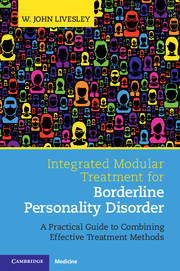 Integrated Modular Treatment for Borderline Personality Disorder
Integrated Modular Treatment for Borderline Personality Disorder Book contents
- Frontmatter
- Dedication
- Contents
- Preface
- Section 1 Introduction and Framework for Understanding Borderline Personality Disorder
- Section 2 Assessment and Treatment Planning
- Section 3 General Treatment Modules
- Section 4 Safety, Containment, and Engagement: The Initial Phase of Treatment
- Section 5 Improving Emotional Regulation and Modulation
- Section 6 Exploration and Change: Treating Interpersonal Problems
- Section 7 Constructing an Adaptive Sense of Self
- Section 8 Retrospect and Prospect
- 24 Termination and Overview: The Treatment Process across Time
- References
- Index
24 - Termination and Overview: The Treatment Process across Time
from Section 8 - Retrospect and Prospect
Published online by Cambridge University Press: 16 February 2017
- Frontmatter
- Dedication
- Contents
- Preface
- Section 1 Introduction and Framework for Understanding Borderline Personality Disorder
- Section 2 Assessment and Treatment Planning
- Section 3 General Treatment Modules
- Section 4 Safety, Containment, and Engagement: The Initial Phase of Treatment
- Section 5 Improving Emotional Regulation and Modulation
- Section 6 Exploration and Change: Treating Interpersonal Problems
- Section 7 Constructing an Adaptive Sense of Self
- Section 8 Retrospect and Prospect
- 24 Termination and Overview: The Treatment Process across Time
- References
- Index
Summary
The main treatment methods and strategies required for an integrated and trans-theoretical approach to treating borderline personality disorder (BPD) have now been discussed as they apply to the different domains of personality pathology. Now all that remains is to discuss one final issue – termination – and to revisit some key issues such as the duration of therapy, pathways of care, and the flow of therapy across time, based on an understanding of the overall structure and process of integrated modular treatment (IMT).
Termination
As with most aspects of IMT, the decision about when and how to end therapy should be collaborative. Usually, the probable duration of therapy is discussed in general terms when establishing the treatment contract so that from the outset of therapy there is a general understanding about when and how treatment will end. If this discussion does not occur prior to treatment because the patient is too decompensated as was the case with Anna, it should occur as soon as possible to reduce any anxiety the patient may have about the therapist terminating treatment – a common fear. For example, Anna mentioned her concern about the therapist abandoning her early in treatment because this had occurred in previous therapies. Consequently, during an early session when Anna was in a less-decompensated state, the therapist explained the treatment would probably take several years and that this should be reviewed jointly as therapy progressed.
With most patients, the duration of therapy is discussed again whenever new treatment goals are established as therapy progresses. A more detailed discussion of termination usually occurs when frequency of therapy is discussed when treatment progresses beyond the regulation and modulation phase because the frequency of sessions can often be reduced at this time, an issue that will be discussed later. This approach to termination means termination is approached gradually and the patient is prepared for therapy ending well in advance. At each step in the process, the patient's concerns are addressed and it is emphasized that the decision to end therapy will only be reached after a joint discussion. This allows patients who are anxious about treatment ending to feel more in control of the process and to set a pace that they are comfortable with.
- Type
- Chapter
- Information
- Integrated Modular Treatment for Borderline Personality DisorderA Practical Guide to Combining Effective Treatment Methods, pp. 263 - 272Publisher: Cambridge University PressPrint publication year: 2017


